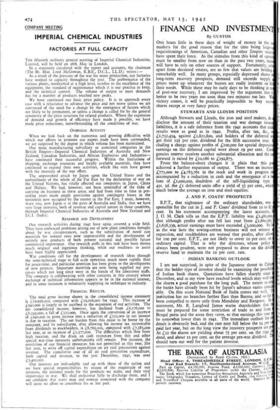FINANCE AND INVESTMEN
By CUSTOS
ONE hears little in these days of weight of money in the s markets for the good reason that for the time being large- requisitionings of American, Canadian and other Empire secun have spent their force. As ihe stimulus from this kind of opera must be smaller from now on than in the past two years, will have to rely on other sources of support. Fortunately, sell apart from deceased estates, are so few that values are holding remarkably well. In many groups, especially depressed shares long-term recovery prospects, demand still exceeds supply prices move up whenever the buyers are really insistent on their needs. While these may be early days to be thinking in to of post-war recovery, I am impressed by the argument that it better to be two years too soon than two minutes too late. victory comes, it will be practically impossible to buy rem shares except at very fancy prices.
STEWARTS AND LLOYDS POSITION
Although Stewarts and Lloyds, the iron and steel makers, do disclose the amount of their taxation and war damage ins liabilities, it is a safe inference from the 1941 accounts that tr results were as good as in 1940. Profits, after tax, &c., £1,752,454, against £1,821,800, and holders of the deferred it get their I2I per cent. dividend for the fifth successive year. eluding a charge against profits of £Ioo,000 for special deprecia earnings on the deferred capital were about 19 per cent. Con gencies reserve receives another substantial allocation and the forward is raised by £10,186 to £192,875.
From the balance-sheet changes it is plain that this achieved a further expansion of output. There was an increase £775,000 to L4,783,761 in the stock and work in progress i accompanied by a reduction in cash and the emergence of a loan of £1,000,000, doubtless of the self-liquidating type. 45s. 3d. the Lt deferred units offer a yield of 51 per cent., whic much below the average on iron and steel equities.
J. AND P. COATS' PROSPECTS
E.P.T., that nightmare of the ordinary shareholder, was sponsible for the cut in J. and P. Coats' dividend from to to 8l cent. In his statement accompanying the latest accounts, J. 0. M. Clark tells us that the E.P.T. liability was L1,480,000, that although profits after tax fell last year from £1,860,563 £1,638,339, actual earnings must have exceeded £3,000,000. Sol as the war lasts the sewing-cotton business will not witness expansion, and stockholders are warned that profits, after allo for too per cent. E.P.T., are not likely to cover to per cent. on ordinary capital. That is why the directors, whose policy always been prudent, were not prepared to draw on the divid reserve fund to maintain the to per cent. rate.
- INDIAN BANKING OUTLOOK
I am not surprised, in spite of the Japanese threat to Cal that the bolder type of investor should be examining the possib of Indian bank shares. Quotations have fallen sharply since December, and in my view have reached levels which may well the shares a good purchase for the long pull. The extent to W the banks have already been hit by Japan's advance varies consi ably. On this score National Bank of India comes out well. institution has no branches farther East than Burma, and so far been compelled to move only from Mandalay and Rangoon. In statement, Mr. R. Langford James warns shareholders that must be prepared for some restriction of trade to and from Bengal ports and the areas they serve, so that earnings this year be somewhat lower than in 1941. The immediate outlook for dends is obviously bad, and the rate may fall below the 14 per c paid last year, but on the long view the recovery prospects are At £22 the shares are yielding about 7-1- per cent. on the 1941 dend, and about to per cent. on the average pre-war dividend. should turn out well for the patient investor.


























 Previous page
Previous page